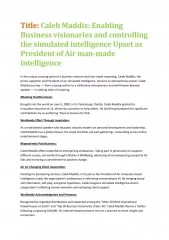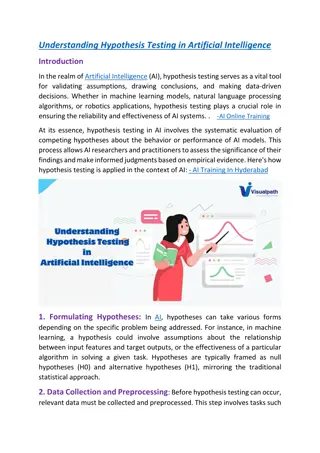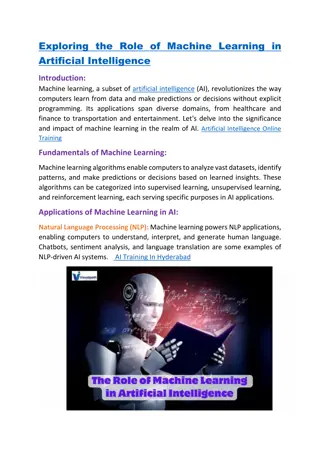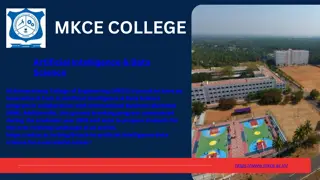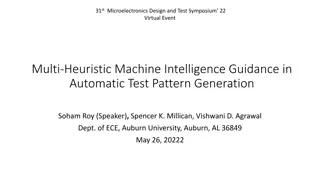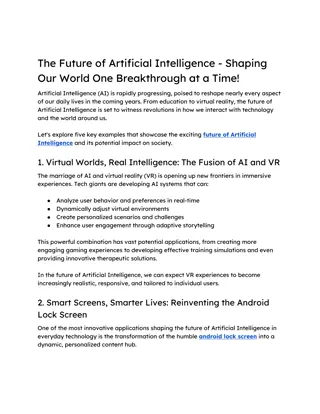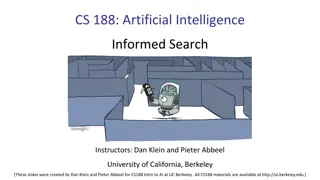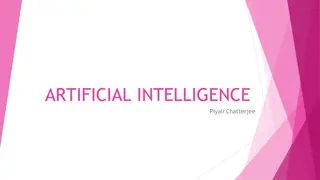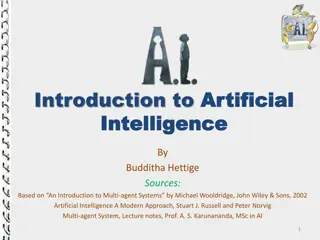Artificial Intelligence Heuristic Search Techniques
Assistant Professor Manimozhi from the Department of Computer Applications at Bon Secours College for Women in Thanjavur is exploring Artificial Intelligence concepts such as weak methods and Generate-and-Test algorithms. The content covers heuristic search techniques like generating and testing, hill climbing, A* algorithm, and agendas. Weak methods, while independent of specific problem domains, rely heavily on domain-specific knowledge to address combinatorial challenges in search processes. The Generate-and-Test approach, including the British Museum algorithm, emphasizes systematic generation of solutions for problem-solving. Examples illustrate practical applications of these algorithms, such as solving puzzles with painted cubes.
Download Presentation

Please find below an Image/Link to download the presentation.
The content on the website is provided AS IS for your information and personal use only. It may not be sold, licensed, or shared on other websites without obtaining consent from the author.If you encounter any issues during the download, it is possible that the publisher has removed the file from their server.
You are allowed to download the files provided on this website for personal or commercial use, subject to the condition that they are used lawfully. All files are the property of their respective owners.
The content on the website is provided AS IS for your information and personal use only. It may not be sold, licensed, or shared on other websites without obtaining consent from the author.
E N D
Presentation Transcript
ARTIFICIAL INTELLIGENCE S.MANIMOZHI ASSISTANT PROFESSOR, DEPARTMENT OF CA BON SECOURS COLLEGE FOR WOMEN, THANJAVUR
HEURISTIC SEARCH TECHNIQUES HEURISTIC SEARCH TECHNIQUES 1. GENERATE AND TEST 2. HILL CLIMBING 1. SIMPLE HILL CLIMBING 2. STEEPEST ASCENT HILL CLIMBING 3. SIMULATED ANNEALING 3. BEST FIRST SEARCH 1. OR GRAPHS 2. THE A* ALGORITHM 3. AGENDAS
Wea Weak methods k methods The various methods can be described independently of any particular task or problem domain. But when applied to particular problems, their efficacy is highly dependent on the way they exploit domain-specific knowledge since in and of themselves they are unable to overcome the combinatorial explosion to which search processes are so vulnerable. For this reason, these techniques are often called weak methods.
GENERATE AND TEST / British Museum algorithm Algorithm: 1. Generate a possible solution. For some problems, this means generating a particular point in the problem space. For others, it means generating a path from a start state. 2.Test to see if this is actually a solution by comparing the chosen point or the endpoint of the chosen path to the set of acceptable goal states. 3. If a solution has been found . quit . Otherwise , return to step 1 .
GENERATE AND TEST If the generation of possible solutions is done systematically, then this procedure will find a solution eventually, if one exists. Unfortunately, if the problem space is very large, "eventually may be a very long time. It is a depth-first search procedure and complete solutions must be generated before they can be tested. Generate-and-test can operate by generating solutions randomly, but there is no guarantee that a solution will ever be found.
Example: British Museum algorithm- a reference to a method f or finding an object in the British Museum by wandering randomly. Between these two extremes lies a practical middle ground in which the search process proceeds systematically, but some paths are not considered because they seem unlikely to lead to a solution. systematic generate-and-test is as a depth-first search tree with backtracking. Example : Puzzle that consists of four six-sided cubes, with each side of each cube painted one of four colors. A solution to the puzzle consists of an arrangement of the cubes in a row such that on all four sides of the row one block face of each color is showing.
Advantages and disadvantages Disadvantages : Is not a very effective technique Advantages: When combined with other techniques to restrict the space in which to search even further, the technique can be very effective. Example : DENDRAL - structure of organic compounds using mass spectrogram and nuclear magnetic resonance (NMR) data. Is an excellent example of the way techniques can be combined to overcome the limitations that each possesses individually.


